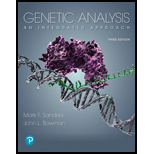
Concept explainers
You have discovered a new species of Archaea from a hot spring in Yellowstone National Park.
After growing a pure culture of this prokaryote, what strategy might you employ to sequence its genome?
How would your strategy change if you were unable to grow the strain in culture?
To analyze:
Considering a new species of Archaea from a hot spring in Yellowstone National Park, answer the following –
The strategy that might be employed to sequence its genome, after growing a pure culture of this prokaryote.
The change in strategy if the strain is unable to grow in culture.
Introduction:
In prokaryotes, genome consists of a single DNA molecule. These genomes are much longer than the genome lengths that can be sequenced using a traditional single dideoxy sequencing reaction. An efficient way of sequencing DNA molecule involves breaking the whole DNA into smaller fragments and sequencing the fragments in parallel.
Explanation of Solution
The DNA sequence of the newly discovered organism can be obtained using whole-genome shotgun (WGS) sequencing. WGS sequences genomic DNA by the shotgun method which does not require prior construction of a physical map. Therefore, WGS can be applied to any genome. The entire DNA of an organism can be sequenced using this approach. As it is possible to grow a pure culture of newly discovered archaea, the entire DNA (large quantity) can be obtained for sequencing (this is not possible for unculturable microorganisms). In WGS, DNA representing the entire genome is fragmented into smaller pieces and a large number of fragments are randomly chosen to sequence.
If it is assumed that the strain cannot be cultured, conventional WGS sequencing cannot be used for sequencing. Metagenomics studies the genetic sequences of groups of organisms whose member species is difficult to culture. In this approach, environmental samples where targeted organisms are present are collected and filtered. The genomes of organisms in the sample are isolated and are cloned into vectors. Sequencing of clones is performed randomly to reconstruct consensus sequence.
The newly discovered archaea can be sequenced using whole genome shotgun sequencing approach if it is cultivable. If the organism is assumed to not be cultivable, metagenomics approach can be used for sequencing the genome.
Want to see more full solutions like this?
Chapter 16 Solutions
Genetic Analysis: An Integrated Approach (3rd Edition)
- For short answer questions, write your answers on the line provided. To the right is the mRNA codon table to use as needed throughout the exam. First letter U บบบ U CA UUCPhe UUA UCU Phe UCC UUG Leu CUU UAU. G U UAC TV UGCys UAA Stop UGA Stop A UAG Stop UGG Trp Ser UCA UCG CCU] 0 CUC CUA CCC CAC CAU His CGU CGC Leu Pro CCA CAA Gin CGA Arg CUG CCG CAG CGG AUU ACU AAU T AUC lle A 1 ACC Thr AUA ACA AUG Mot ACG AGG Arg GUU GCU GUC GCC G Val Ala GAC Asp GGU GGC GUA GUG GCA GCG GAA GGA Gly Glu GAGJ GGG AACASH AGU Ser AAA1 AAG Lys GAU AGA CAL CALUCAO CAO G Third letter 1. (+7) Use the table below to answer the questions; use the codon table above to assist you. The promoter sequence of DNA is on the LEFT. You do not need to fill in the entire table. Assume we are in the middle of a gene sequence (no need to find a start codon). DNA 1 DNA 2 mRNA tRNA Polypeptide C Val G C. T A C a. On which strand of DNA is the template strand (DNA 1 or 2)?_ b. On which side of the mRNA is the 5' end (left or…arrow_forward3. (6 pts) Fill in the boxes according to the directions on the right. Structure R-C R-COOH OH R-OH i R-CO-R' R R-PO4 R-CH3 C. 0 R' R-O-P-OH 1 OH H R-C-H R-N' I- H H R-NH₂ \H Name Propertiesarrow_forward4. (6 pts) Use the molecule below to answer these questions and identify the side chains and ends. Please use tidy boxes to indicate parts and write the letter labels within that box. a. How many monomer subunits are shown? b. Box a Polar but non-ionizable side chain and label P c. Box a Basic Polar side chain and label BP d. Box the carboxyl group at the end of the polypeptide and label with letter C (C-terminus) H H OHHO H H 0 HHO H-N-CC-N-C-C N-C-C-N-GC-OH I H-C-H CH2 CH2 CH2 H3C-C+H CH2 CH2 OH CH CH₂ C=O OH CH2 NH2arrow_forward
- please draw in what the steps are given. Thank you!arrow_forwardplease draw in and fill out the empty slots from image below. thank you!arrow_forwardThere is a species of eagle, which lives in a tropical forest in Brazil. The alula pattern of its wings is determined by a single autosomal gene with four alleles that exhibit an unknown hierarchy of dominance. Genetic testing shows that individuals 1-1, 11-4, 11-7, III-1, and III-4 are each homozygous. How many possible genotypes among checkered eagles in the population?arrow_forward
 Concepts of BiologyBiologyISBN:9781938168116Author:Samantha Fowler, Rebecca Roush, James WisePublisher:OpenStax College
Concepts of BiologyBiologyISBN:9781938168116Author:Samantha Fowler, Rebecca Roush, James WisePublisher:OpenStax College Biology Today and Tomorrow without Physiology (Mi...BiologyISBN:9781305117396Author:Cecie Starr, Christine Evers, Lisa StarrPublisher:Cengage Learning
Biology Today and Tomorrow without Physiology (Mi...BiologyISBN:9781305117396Author:Cecie Starr, Christine Evers, Lisa StarrPublisher:Cengage Learning Human Biology (MindTap Course List)BiologyISBN:9781305112100Author:Cecie Starr, Beverly McMillanPublisher:Cengage Learning
Human Biology (MindTap Course List)BiologyISBN:9781305112100Author:Cecie Starr, Beverly McMillanPublisher:Cengage Learning Biology (MindTap Course List)BiologyISBN:9781337392938Author:Eldra Solomon, Charles Martin, Diana W. Martin, Linda R. BergPublisher:Cengage Learning
Biology (MindTap Course List)BiologyISBN:9781337392938Author:Eldra Solomon, Charles Martin, Diana W. Martin, Linda R. BergPublisher:Cengage Learning Human Heredity: Principles and Issues (MindTap Co...BiologyISBN:9781305251052Author:Michael CummingsPublisher:Cengage Learning
Human Heredity: Principles and Issues (MindTap Co...BiologyISBN:9781305251052Author:Michael CummingsPublisher:Cengage Learning





